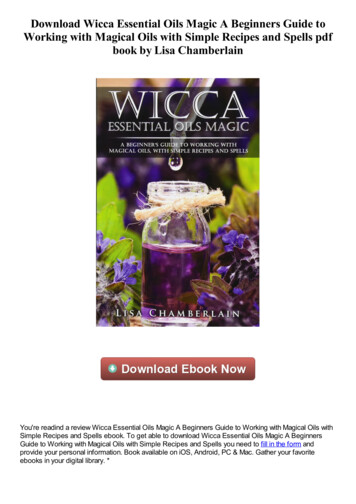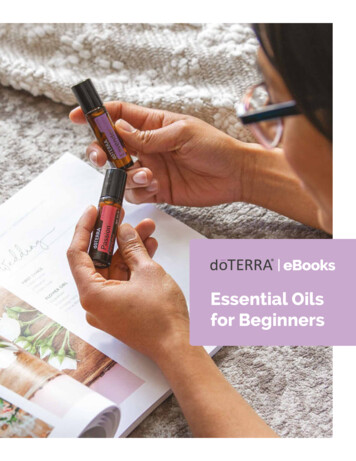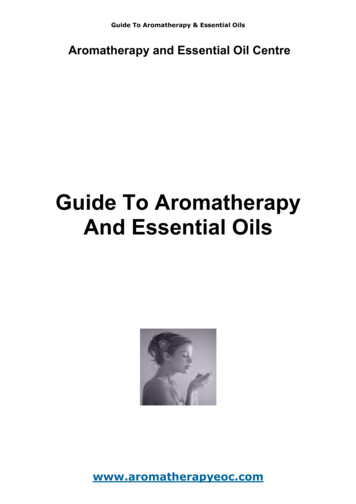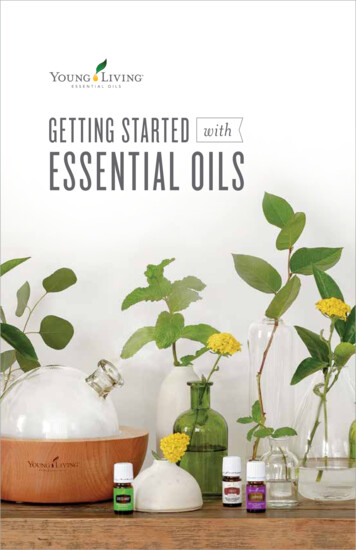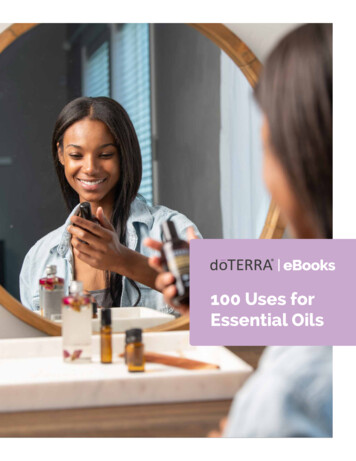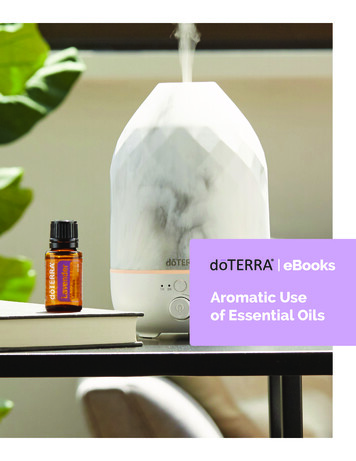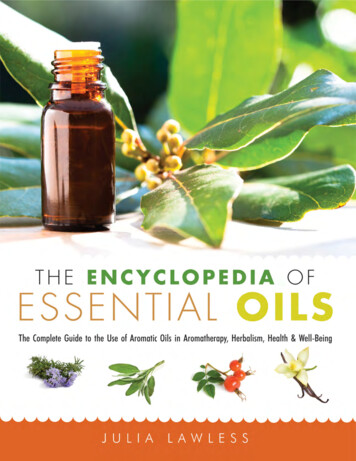
Transcription
Julia Lawless has been interested in aromatic oils since she was a child, whenher mother, who was a biochemist, became involved in research in essentialoils. In 1983 she took over the responsibility for the formulation of naturalproducts using the oils for Aqua Oleum, the family business. She has studiedthe Western and Tibetan herbal medicine, and is a qualified aromatherapistand member of the International Federation of Aromatherapists.To my mother, KerttuPublished by arrangement with HarperCollins Publishers LtdFirst published 2002 Julia Lawless 2001This 2013 edition published by Conari Press,an imprint of Red Wheel/Weiser, LLC with offices at:665 Third Street, Suite 400,San Francisco, CA 94107www.redwheelweiser.com Julia Lawless 1992, 2013Cover design by Jim WarnerEssential oil laurel Lucenet Patrice/Oredia Eurl/SuperStockBotanical illustrations by Sarah RocheJulia Lawless asserts the moral right to beidentified as the author of this workAll rights reserved. No part of this publication may bereproduced or transmitted in any form or by any means, electronic ormechanical, including photocopying, recording, or by any information storageand retrieval system, without permission in writing from Conari Press.Reviewers may quote brief passages.ISBN: 978-1-57324-614-9Library of Congress Cataloging-in-Publication Data is available upon requestPrinted and bound in China by South China Printing Co. Ltd.
CONTENTSPrefaceHow to Use This BookPart I: An Introduction to Aromatics1. Historical Roots Natural Plant Origins Ancient Civilizations Treasures from the East Alchemy The Scientific Revolution 2. Aromatherapy and Herbalism The Birth of Aromatherapy Herbal Medicine Therapeutic Guidelines Safety Precautions 3. The Body - Actions andApplications How Essential Oils Work The Skin The Circulation, Muscles and Joints The Respiratory System The Digestive System The Genito-urinary and EndocrineSystems The Immune System The Nervous System The Mind 4. How to use Essential Oils at Home Massage Skin Oils and Lotions Hot and Cold Compresses Hair Care Flower Waters Baths Vaporization Steam Inhalation Douche Neat Application Internal Use 5. Creative Blending Therapeutic and Aesthetic Properties Correct Proportions Synergies Fragrant Harmony Personal Perfumes 6. A Guide to Aromatic Materials Habitat Chemistry Methods of Extraction Natural versus ‘Nature Identical’
6The Encyclopaedia of Essential Oils Part II The OilsAjowanAllspiceAlmond, Bitter Ambrette Seed AmyrisAngelicaAnise, Star AniseedArnicaAsafetidaBalm, Lemon Balsam, Canadian Balsam, Copaiba Balsam, Peru Balsam, Tolu Basil, Exotic Basil, French Bay Laurel Bay, West Indian BenzoinBergamotBirch, Sweet Birch, White Boldo Leaf BorneolBoroniaBroom, Spanish nangaCarawayCardomonCarrot Seed Cascarilla Bark CassiaCassieCedarwood, Atlas Cedarwood, Texas CedarwoodVirginianCelery Seed Chamomile, eertongueDillElecampaneElemiEucalyptus, BlueGumEucalyptus,Lemon-Scented Eucalyptus, Broad-leavedPeppermintFennelFir Needle, Silver FrankincenseGalangalGalbanum Gardenia Garlic Geranium Ginger Grapefruit Guaiacwood Helichrysum Hops Horseradish Hyacinth Hyssop Jaborandi Jasmine Juniper Labdanum Lavandin Lavender, Spike Lavender, True Lemon Lemongrass Lime Linaloe Linden Litsea Cubeba Lovage Mandarin Marigold Marjoram, Sweet Mastic Melilotus Mimosa Mint, Cornmint Mint,PeppermintMint, Spearmint mossOnionOpopanaxOrange, Bitter
Contents 7Orange Blossom Orange, Sweet Oregano,Common Oregano,Spanish Orris Palmarosa Parsley Patchouli Pennyroyal Pepper, Black Petitgrain Pine, Dwarf Pine, Longleaf Pine, Scotch Rose, Cabbage Rose, Damask Rosemary Rosewood Rue Sage, Clary Sage, Common Sage, Spanish Sandalwood Santolina Sassafras Savine Savory, Summer Savory, Winter Schinus Molle Snakeroot Spikenard Spruce, Hemlock Styrax, Levant Tagetes Tansy Tarragon AcknowledgementsReferencesBibliographyUseful AddressesTherapeutic IndexGeneral GlossaryBotanical ClassificationBotanical IndexWoodcut from the title page of the Grete Herball, 1526Tea Tree Thuja Thyme,Common Tonka Tuberose Turmeric Turpentine Valerian Vanilla Verbena, Lemon Vetiver Violet Wintergreen Wormseed Wormwood Yarrow Ylang Ylang
PrefaceMy own interest in essential oils and herbal remedies derives from thematernal side of my family who came from Finland, where home ‘simples’retained popularity long after they had vanished from most parts of Britain.My Finnish grandmother knew a great deal about herbs and wild plantswhich she passed on to my mother, as she recalls:Mama’s most important herb was parsley, which along with dill,marjoram, hops and others, were dried in bunches in the autumn,dangling at the ends of short lengths of cotton, all strung on a longlength of thin rope stretching right across the kitchen stove. As scentsare very evocative for remembering old things, I remember it so well –the strong and heady smell emanating from these herbs when theywere hung up, and the stove was warm.Later, as a biochemist, my mother became involved with the research ofessential oils and plants, and helped inspire in me a fascination for herbsand the use of natural remedies. Without her early enthusiasm and guid ance, I’m sure this book would never have been written.In 1992 the first edition of this book was published in the UK. Since thenit has been translated into many languages as well being released in severaldifferent formats, including an illustrated edition. With this new edition, Iam very glad to have the opportunity to update my original work and add afew words to this preface.In the twenty-year period since the original publication of The Encyclopediaof Essential Oils, the use of essential oils, together with the practice ofaromatherapy in the West has undergone a radical transformation. At thebeginning of the 1990s, aromatherapy was still considered a fringe practiceand the use of essential oils in the home was by no means widespread.However, as scientific trials and clinical research have continued to confirmthe potentiality of essential oils, they have become increasingly respectedwithin the medical arena. This has been accompanied by a steady increaseof public interest in holistic therapies and a sociological trend towardsembracing all things ‘natural’ over the past two decades in Europe and theUnited States.Nowadays, aromatherapy treatments are widely available and oftenoffered in hospitals, while essential oils can be purchased in every town.This change in attitude has bought so many benefits, but it is worth alsoconsidering the dangers that have emerged with the commercialization ofaromatherapy. Although essential oils are all wholly natural substances, theycan be subject to adulteration, so it is important to always buy them froma reputable supplier (see page 198). It is also vital to check that any specificsafety guidelines are followed with care at home. It is my hope that thisnew edition brings fresh life to the multifaceted and multicultural study ofessential oils and to the field of contemporary aromatherapy.
How to Use This BookThe Encyclopaedia of Essential Oils is divided into two parts:Part I is a general introduction to aromatics, showing their changing role throughout history, fromthe ritual part they played in ancient civilizations, through medieval alchemy, to their modern dayapplications in aromatherapy, herbalism and perfumery.Part II is a systematic survey of over 160 essential oils shown in alphabetical order according to thecommon name of the plants from which they are derived. Detailed information on each oil includes itsbotanical origins, herbal/folk tradition, odour characteristics, principal constituents and safety data, aswell as its home and commercial uses.This book can be approached in several ways:1. It can be employed as a concise reference guide to a wide range of aromatic plants and oils, in thesame way as a traditional herbal.2. It can be used a self-help manual, showing how to use aromatherapy oils at home for the treatmentof common complaints and to promote well-being.3. It can be read from cover to cover as a comprehensive textbook on essential oils, shown in all theirdifferent aspects.1. When using the book as a reference guide to essential oils, the name of the plant or oil may be foundin the Botanical Index at the back of the book, where it is listed under:a) its common name: for example, frankincense;b) its Latin or botanical term: Boswellia carteri;c) its essential oil trade name: olibanum;d) or by its folk names: gum thus.Other varieties, such as Indian frankincense (Boswellia serrata), may be found in the BotanicalClassification section under their common family name ‘Burseraceae’, along with related species suchas elemi, linaloe, myrrh and opopanax. Less common essential oils, such as blackcurrant (which isused mainly by the food industry), do not appear in the main body of the book, but are included in theBotanical Classification section under their common family name, in this case ‘Grossulariaceae’.2. When using the book as a self-help manual on aromatherapy, it is best to consult the TherapeuticIndex at the end of the book, where common complaints are grouped according to different parts ofthe body: Skin CareCirculation, Muscles and JointsRespiratory SystemDigestive SystemGenito-urinary and Endocrine SystemsImmune SystemNervous SystemIf for example, we have been working long hours at a desk and have developed a painful crampin our neck, we should turn to the section on Circulation, Muscles and Joints where we find theheading ‘Muscular Cramp and Stiffness’. Of the essential oils which are listed, those shown in italicsare generally considered to be the most useful and/or readily available, in this case allspice, lavender,marjoram, rosemary and black pepper.
The choice of which oil to use depends on what is to hand, and on assessing the quality of eachoil by consulting their entry in Part II of the book. Special attention should be paid to the SafetyData on each oil: both allspice and black pepper are known to be skin irritants if used in highconcentration; rosemary and marjoram should be avoided during pregnancy; rosemary should not beused by epileptics at all. On the basis of our assessment, we may choose to use lavender, marjoram anda little black pepper which would make an excellent blend. Some of the principles behind blending oilscan be found in Chapter 5, Creative Blending.The various methods of application are indicated by the letters M, massage; C, compress; B, bathetc. Turn to Chapter 4, How to Use Essential Oils at Home, where you will find instructions on howto make up a massage oil or compress, and how many drops of oil to use in a bath. Further informationon how essential oils work in specific cases can be found in Chapter 3, The Body – Actions andApplications.3. Used as a comprehensive textbook, The Encyclopaedia of Essential Oils provides a wealth ofinformation about the essential oils themselves in all their various aspects, including their perfumeryand flavouring applications. It shows the development of aromatics through history and therelationship between essential oils and other herbal products. It defines different kinds of aromaticmaterials and their methods of extraction, giving up-to-date areas of production. In addition, it includesinformation on their chemistry, pharmacology and safety levels. The ‘Actions’ ascribed to each plantrefer either to the properties of the whole herb, or to parts of it, or to the essential oil. Difficult technicalterms, mainly of a botanical or medical nature, are explained in the General Glossary at the end ofthe book.However, since the therapeutic guidelines presented in the text are aimed primarily at the lay personwithout medical qualifications, the section dealing with the aromatherapy application of essentialoils at home is limited to the treatment of common complaints only. Although there is a great dealof research being carried out at present into the potential uses of essential oils in the treatment ofdiseases such as cancer, AIDS and psychological disorders, these discussions fall beyond the scopeof this book. References to the medical and folk use of particular plants in herbal medicine and theiractions are intended to provide background information only, and are not intended as a guide for selftreatment.
PART I: AN INTRODUCTION TO AROMATICS
1. HISTORICAL ROOTSNatural Plant OriginsWhen we peel an orange, walk through a rose garden or rub a sprig of lavender between our fingers,we are all aware of the special scent of that plant. But what exactly is it that we can smell? Generallyspeaking, it is essential oils which give spices and herbs their specific scent and flavour, flowers andfruit their perfume. The essential oil in the orange peel is not difficult to identify; it is found in suchprofusion that it actually squirts out when we peel it. The minute droplets of oil which are contained intiny pockets or glandular cells in the outer peel are very volatile, that is, they easily evaporate, infusingthe air with their characteristic aroma.But not all plants contain essential or volatile oils in such profusion. The aromatic content in theflowers of the rose is so very small that it takes one ton of petals to produce 300g of rose oil. It isnot fully understood why some plants contain essential oils and others not. It is clear that the aromaticquality of the oils plays a role in the attraction or repulsion of certain insects or animals. It has alsobeen suggested that they play an important part in the transpiration and life processes of the plant itself,and as a protection against disease. They have been described as the ‘hormone’ or ‘life-blood’ of aplant, due to their highly concentrated and essential nature.Aromatic oils can be found in all the various parts of a plant, including the seeds, bark, root, leaves,flowers, wood, balsam and resin. The bitter orange tree, for example, yields orange oil from the fruitpeel, petitgrain from the leaves and twigs, and neroli oil from the orange blossoms. The clove treeproduces different types of essential oil from its buds, stalks and leaves, whereas the Scotch pine yieldsdistinct oils from its needles, wood and resin. The wide range of aromatic materials obtained fromnatural sources and the art of their extraction and use has developed slowly over the course of time,but its origins reach back to the very heart of the earliest civilizations.Ancient CivilizationsAromatic plants and oils have been used for thousands of years, as incense, perfumes and cosmeticsand for their medical and culinary applications. Their ritual use constituted an integral part of thetradition in most early cultures, where their religious and therapeutic roles became inextricablyintertwined. This type of practice is still in evidence: for example, in the East, sprigs of juniper areburnt in Tibetan temples as a form of purification; in the West, frankincense is used during the RomanCatholic mass.In the ancient civilizations, perfumes were used as an expression of the animist and cosmicconceptions, responding above all to the exigencies of a cult associated at first with theophaniesand incantations, the perfumes made by fumigation, libation and ablution, grew directly out of theritual, and became an element in the art of therapy.1The Vedic literature of India dating from around 2000 BC, lists over 700 substances includingcinnamon, spikenard, ginger, myrrh, coriander and sandalwood. But aromatics were considered to bemore than just perfumes; in the Indo-Aryan tongue, ‘atar’ means smoke, wind, odour and essence, andthe Rig Veda codifies their use for both liturgical and therapeutic purposes. The manner in which itis written reflects a spiritual and philosophical outlook, in which humanity is seen as a part of nature,and the handling of herbs as a sacred task: ‘Simples, you who have existed for so long, even before theGods were born, I want to understand your seven hundred secrets! Come, you wise plants, heal thispatient for me’.2 Their understanding of plant lore developed into the traditional Indian or Ayurvedicsystem of medicine, which has enjoyed an unbroken transmission up to the present day.The Chinese also have an ancient herbal tradition which accompanies the practice of acupuncture,the earliest records being in the Yellow Emperor’s Book of Internal Medicine dating from more than2000 years BC. Among the remedies are several aromatics such as opium and ginger which, apart fromtheir therapeutic applications, are known to have been utilized for religious purposes since the earliest
times, as in the Li-ki and Tcheou-Li ceremonies. Borneo camphor is still used extensively in Chinatoday for ritual purposes.But perhaps the most famous and richest associations concerning the first aromatic materials arethose surrounding the ancient Egyptian civilization. Papyrus manuscripts dating back to the reign ofKhufu, around 2800 BC, record the use of many medicinal herbs, while another papyrus written about2000 BC speaks of ‘fine oils and choice perfumes, and the incense of temples, whereby every godis gladdened’.3 Aromatic gums and oils such as cedar and myrrh were employed in the embalmingprocess, the remains of which are still detectable thousands of years later, along with traces of scentedunguents and oils such as styrax and frankincense contained in a number of ornate jars and cosmeticpots found in the tombs. The complete iconography covering the process of preparation for such oils,balsams and fermented liqueurs was preserved in stone inscriptions by the people of the Nile valley.The Egyptians were, in fact, experts of cosmetology and renowned for their herbal preparations andointments. One such remedy was known as ‘kyphi’; a mixture of sixteen different ingredients whichcould be used as an incense, a perfume or taken internally as a medicine. It was said to be antiseptic,balsamic, soothing and an antidote to poison which, according to Plutarch, could lull one to sleep, allayanxieties and brighten dreams.Treasures from the EastNatural aromatics and perfume materials constituted one of the earliest trade items of the ancientworld, being rare and highly prized. When the Jewish people began their exodus from Egypt to Israelaround 1240 BC, they took with them many precious gums and oils together with knowledge of theiruse. On their journey, according to the Book of Exodus, the Lord transmitted to Moses the formulafor a special anointing oil, which included myrrh, cinnamon, calamus, cassia and olive oil among itsingredients. This holy oil was used to consecrate Aaron and his sons into priesthood, which continuedfrom generation to generation. Frankincense and myrrh, as treasures from the East, were offered toJesus at his birth.The Phoenician merchants also exported their scented oils and gums to the Arabian peninsula andgradually throughout the Mediterranean region, particularly Greece and Rome. They introduced theWest to the riches of the Orient: they brought camphor from China, cinnamon from India, gums fromArabia and rose from Syria, always ensuring that they kept their trading routes a closely guardedsecret.The Greeks especially learnt a great deal from the Egyptians; Herodotus and Democrates, whovisited Egypt during the fifth century BC, were later to transmit what they had learnt about perfumeryand natural therapeutics. Herodotus was the first to record the method of distillation of turpentine, inabout 425 BC, as well as furnishing the first information about perfumes and numerous other detailsregarding odorous materials. Dioscorides made a detailed study of the sources and uses of plants andaromatics employed by the Greeks and Romans which he compiled into a five volume materia medica,known as the Herbarius.Hippocrates who was born in Greece about 460 BC and universally revered as the ‘father ofmedicine’, also prescribed perfumed fumigations and fomentations; indeed ‘from Greek medicalpractice there is derived the term ‘iatralypte’, from the physician who cured by the use of aromaticunctions’.4 One of the most famous of these Greek preparations, made from myrrh, cinnamon andcassia, was called ‘megaleion’ after its creator Megallus. Like the Egyptian ‘kyphi’, it could be usedboth as a perfume and as a remedy for skin inflammation and battle wounds.The Romans were even more lavish in their use of perfumes and aromatic oils than the Greeks. Theyused three kinds of perfumes: ‘ladysmata’, solid unguents; ‘stymmata’, scented oils; and ‘diapasmata’,powdered perfumes. They were used to fragrance their hair, their bodies, their clothes and beds; largeamounts of scented oil were used for massage after bathing. With the fall of the Roman Empire andthe advent of Christianity, many of the Roman physicians fled to Constantinople taking the books ofGalen, Hippocrates and Dioscorides with them. These great Graeco-Roman works were translated intoPersian, Arabic and other languages, and at the end of the Byzantine Empire, their knowledge passedon to the Arab world. Europe, meanwhile, entered the so-called Dark Ages.
AlchemyBetween the seventh and thirteenth centuries the Arabs produced many great men of science, amongthem Avicenna (AD 980‒1037). This highly gifted physician and scholar wrote over a hundred booksin his lifetime, one of which was devoted entirely to the flower most cherished by Islam, the rose.Among his discoveries, he has been credited with the invention of the refrigerated coil, a breakthroughin the art of distillation, which he used to produce pure essential oils and aromatic water. However,in 1975 Dr Paolo Rovesti led an archaeological expedition to Pakistan to investigate the ancient IndusValley civilization. There, in the museum of Taxila at the foot of the Himalayas, he found a perfectlypreserved distillation apparatus made of terracotta. The presence of perfume containers also exhibitedin the museum dating from the same period, about 3000 BC, confirmed its use for the preparation ofaromatic oils. This discovery suggests that the Arabs simply revived or improved upon a process thathad been known for over 4000 years!Rose water became one of the most popular scents and came to the West at the time of theCrusades, along with other exotic essences, and the method of distillation. By the thirteenth century,the ‘perfumes of Arabia’ were famous throughout Europe. During the Middle Ages, floors were strewnwith aromatic plants and little herbal bouquets were carried as a protection against plague and otherinfectious diseases. Gradually the Europeans, lacking the gum-yielding trees of the Orient, began toexperiment with their own native herbs such as lavender, sage and rosemary. By the sixteenth centurylavender water and essential oils known as ‘chymical oils’ could be bought from the apothecary, and,following the invention of printing, the period 1470 to 1670 saw the publication of many herbals suchas the Grete Herball published in 1526, some of which included illustrations of the retorts and stillsused for the extraction of volatile oils.In the hands of the philosophers, the art of distillation was employed in the practice of alchemy,the hermetic pursuit dedicated to the transformation of base metals into gold, the gross into the subtle.It was primarily a religious quest in which the various stages of the distillation process were equatedwith stages of an inner psychic transmutation, ‘dissolution and coagulation’: separation (black, lead),extraction (white, quicksilver), fusion (red, sulphur) and finally sublimation (gold or ‘lapis’). In thesame way that aromatic material could be distilled to produce a pure and potent essence, so couldthe human emotions be refined and concentrated to reveal their valuable fruit, or true nature. Inthis context, volatile oils can be equated with the purified human psyche or ‘quintessence’ of thealchemists, being an emanation of matter and manifestation of spirit, mediator between the two realms.Alchemy was the bridge across which the rich symbolism of the ancient world – Arab, Greek,Gnostic – was transported into our own era thus symbolism fell from the rarefied heights intothe melting-pot, and began to be tested in a continuous, dynamic interaction with the findings ofchemistry.5The Scientific RevolutionThroughout the Renaissance period, aromatic materials filled the pharmacopoeias which for manycenturies remained the main protection against epidemics. Over the next few centuries the medicinalproperties and applications of increasing numbers of new essential oils were analysed and recordedby the pharmacists. The list included both well-established aromatics such as cedar, cinnamon,frankincense, juniper, rose, rosemary, lavender and sage, but also essences like artemisia, cajeput,chervil, orange flower, valerian and pine.The perfumery and distillation industries attracted illustrious names of the day and in the northerncountries of Europe, especially at Grasse in France, flourishing commercial enterprises sprang up. Bythe end of the seventeenth century, the profession of perfumery broke away from the allied fields,and a distinction was made between perfumes and the aromatics that had become the domain of theapothecary.Alchemy gave way to technical chemistry, and with it went the interest in the inter-relatedness ofmatter and spirit, and the interdependence of medicine and psychology. There developed the idea ofcombating speculation with logic and deductive reason. With the scientific revolution of the early
nineteenth century, chemists were able to identify for the first time the various constituents of theoils, and give them specific names such as ‘geraniol’, ‘citronellol’ and ‘cineol’. In the Yearbook ofPharmacy and Transactions of the British Pharmaceutical Conference in 1907, we find for example:A pilea of undetermined botanical species has yielded a white essential oil with an odour ofturpentine A small amount of pinene was detected but its other constituents have not yet beenidentified. This oil is of interest as being the first instance of an essential oil derived from the familyUricaceae.6It is ironic that this enthusiastic research laid the ground for the development of the oils’ syntheticcounterparts, and the growth of the modern drug industry. Herbal medicine and aromatic remedieslost their credibility as methods of treatment went out of the hands of the individual and into thoseof professionals. By the middle of the twentieth century, the role of essential oils had been reducedalmost entirely to their employment in perfumes, cosmetics and foodstuffs.
2. AROMATHERAPY AND HERBALISMThe Birth of AromatherapyThe term ‘aromatherapy’ was first coined in 1928 by Gattefossé, a French chemist working in hisfamily’s perfumier business. He became fascinated with the therapeutic possibilities of the oils afterdiscovering by accident that lavender was able to rapidly heal a severe burn on his hand and helpprevent scarring. He also found that many of the essential oils were more effective in their totalitythan their synthetic substitutes or their isolated active ingredients. As early as 1904 Cuthbert Hall hadshown that the antiseptic power of eucalyptus oil in its natural form was stronger than its isolated mainactive constituent, ‘eucalyptol’ or ‘cineol’.Another French doctor and scientist, Dr Jean Valnet, used essential oils as part of his programme bywhich he was able to successfully treat specific medical and psychiatric disorders, the results of whichwere published in 1964 as Aromatherapie.The work of Valnet was studied by Madame Marguerite Maury who applied his research to herbeauty therapy, in which she aimed to revitalize her clients by creating a ‘strictly personal aromaticcomplex which she adapted to the subject’s temperament and particular health problems. Hence, goingfar beyond any simple aesthetic objective, perfumed essences when correctly selected, represent manymedicinal agents.’7In some respects, the word ‘aromatherapy’ can be misleading because it suggests that it is a formof healing which works exclusively through our sense of smell, and on the emotions. This is not thecase for, apart from its scent, each essential oil has an individual combination of constituents whichinteracts with the body’s chemistry in a direct manner, which then in turn affects certain organs orsystems as a whole. For example, when the oils are used externally in the form of a massage treatment,they are easily absorbed via the skin and transported throughout the body. This can be demonstrated byrubbing a clove of garlic on the soles of the feet; the volatile oil content will be taken into the blood andthe odour will appear on the breath a little while later. It is interesting to note that different essentialoils are absorbed through the skin at varying rates, for example:Turpentine: 20 mins.Eucalyptus and thyme: 20–40 mins.Anise, bergamot and lemon: 40–60 mins.Citronella, pine, lavender and geranium: 60–80 mins.Coriander, rue and peppermint: 100–120 mins.It is therefore important to recognize that essential oils have three distinct modes of action with regardto how they inter-relate with the human body: pharmacological, physiological and psychological. Thepharmacological effect is concerned with the chemical changes which take place when an essentialoil enters the bloodstream and reacts with the hormones and enzymes etc; the physiological mode isconcerned with the way in which an essential oil affects the systems of the body, whether they aresedated or stimulated, etc; the psychological effect takes place when an essence is inhaled, and anindividual responds to its odour. With relation to the first two points, aromatherapy has a great dealin common wit
of Essential Oils, the use of essential oils, together with the practice of aromatherapy in the West has undergone a radical transformation. At the beginning of the 1990s, aromatherapy was still consid


